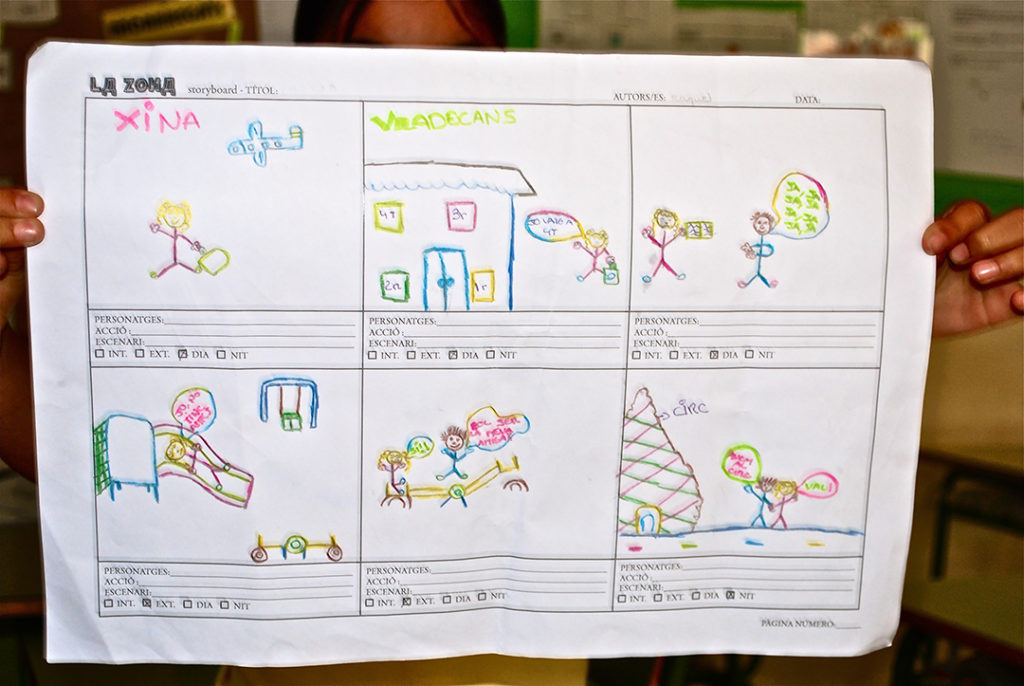

We can affirm that students come from different backgrounds, bring diverse cultural experiences to the classroom, and relate to the world in different ways; the school, in most cases, takes care of standardizing and flattening these different backgrounds. LA ZONA, on the contrary, aims to start from the places, stories, and experiences that constitute the lives of the students, and then connect that knowledge with diverse frames of reference. It seems necessary to us, once again, to generate contexts and devices that enable children to act and modify the structures that they themselves embody.
Once again, this new project starts from the conviction that, as Giroux says, the question of what educators teach is inseparable from what it means to situate oneself and the students in our care in a public dialogue. The audiovisual medium, on this occasion, can serve to place that dialogue in the field of culture, understanding that it is in culture, among other places, where identities are forged. It could also be said that LA ZONA is a space that aims to connect what is done and what happens inside the school with what is done and happens outside of it:
That ‘outside’ of the school places us in the realm of public space1, in the use that children make of public space and the relationship that the school establishes with it. Increasingly, public space is occupied by children only as a place of transit from home to school (a transit that they carry out strictly watched by adults), forming this triad ‘home-road-school’ a kind of prison from which it is not possible to leave. This is not entirely the case for the students of CEIP Dr Fleming, since due to the urban distribution of the place where it is located and the cultural habits of its inhabitants, they have time and space to move freely around the neighborhood. This is perceived from different positions as a risk for them (and for them especially, as always when it comes to the space located beyond the domestic space that is ‘their own’), and in fact it is considered that the school itself constitutes a kind of ‘refuge’ that protects children from the dangers of the outside.
A considerable part of that exterior, of that outside of the school where knowledge is also elaborated and distributed, is that of the audiovisual media. We can say that the representations offered by cinema and television ‘normalize’, that is, they make behaviors that come to be instituted, by dint of repeating their image, as the habits of a series of socially accepted and/or valued identities appear normal to our eyes (and to those of children). This is a function that is not so far from the one that is presupposed to the school itself, however, it seems to mostly ignore the influence of cinema and television on the representations that children give themselves of the world and their relationship with it. This is so despite the countless pedagogical initiatives launched from the administrations, but what is really remarkable about the matter is that the issue is rarely approached from a political perspective2.
The processes and methodology that we will follow in LA ZONA are not especially complex; the project consists of sessions in the classroom that are divided into three moments:
· The students contribute materials (still or moving images, texts, merchandising, etc.) related to those films or television series that seem relevant to them for whatever reason they deem appropriate (because they like them, they have seen them recently…). The selected material is shown or projected in class and collectively debated on various aspects: the way in which the story is told to us, how the characters are represented, who made the film or the object, where we can see it, the type of images that form it, whether it conforms to the canons of some known genre…
· The students create and ‘record’ their own films. First, they expose stories and situations that they have experienced in their daily environment. These are placed on a plane of the neighborhood tracing routes that can then serve to string together the different situations in one or several narratives. These narratives are synthesized in a story-board that will serve to facilitate the recording of the images that will make up the film. We have decided to use sequences of still images to create the films3, this allows us to work with several photographic cameras handled simultaneously by the students themselves.

· The films will be published through a video hosting service on the internet yet to be specified. But beyond this publication, there will be a presentation/premiere in a public place in the neighborhood as a summer cinema. At that time we can also launch the idea of a cineforum in the school in which not only mothers and fathers but also the rest of the neighbors can participate. The films can also be seen on the community television channel Ponentv.net, produced with the help of the mobile publishing units created by Saladestar also within the framework of the Pla de Millora Integral de Ponent, which includes the LA ZONA project.

———————————————
[1] Regarding public space, we think that it would be appropriate to distinguish between common spaces and ‘administered’ or ‘governmental’ spaces, that is, between those spaces that are truly shared and that do not belong privately to anyone and those spaces that, being of public ownership, are strongly regulated preventing in practice a community use of them.
[2] That has nothing to do with «political correctness» or with the false emancipatory character of «visual literacy».
[3] This technique is not the same as stop-motion since this aims to create the illusion of movement. The way in which the still images taken by the children will be assembled will be similar to a photo-novel. A clear reference in the use of this technique is Chris Marker’s short film «La Jetée».